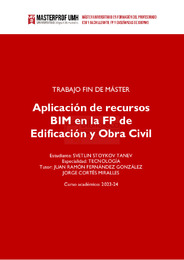Por favor, use este identificador para citar o enlazar este ítem:
https://hdl.handle.net/11000/32882Aplicación de recursos BIM en la FP de Edificación y Obra Civil
| Título : Aplicación de recursos BIM en la FP de Edificación y Obra Civil |
| Autor : Stoykov Tanev, Svetlin |
| Tutor: Fernández González, Juan Ramón Cortés Miralles, Jorge |
| Editor : Universidad Miguel Hernández de Elche |
| Departamento: Departamentos de la UMH::Estadística, Matemáticas e Informática |
| Fecha de publicación: 2024-06 |
| URI : https://hdl.handle.net/11000/32882 |
| Resumen : La regulación modular de los contenidos en la Formación Profesional actual, contempla actividades de diferentes ámbitos pensados para responder al currículo programado, adaptándose a cada ciclo formativo. Sin embargo, su aplicación en la realidad deriva en una compleja estructura que carece de estabilidad que permita englobar la parte teórica con las prácticas correspondientes y completar las tareas previstas para adquirir las habilidades mínimas y cumplir los objetivos marcados en el plan de estudios. Este déficit organizativo se proyecta en el perfil del alumnado, generando un vacío de aptitudes que deja su reflejo sobre el proceso de acceso en el mercado de trabajo. Por otra parte, en la fase inicial de los ciclos formativos, se detecta una mayor necesidad en el trabajo de la motivación del alumno frente a los aprendizajes incluidos en el currículo. La enseñanza tradicional, basada en clases magistrales no consigue dar respuesta adecuada a las demandas, que los alumnos se encuentran a la hora avanzar y cambiar de etapa, y mucho menos a la hora de incorporarse en el mundo laboral. La introducción de metodologías diferentes, como del Aprendizaje Basado en Retos, el Aprendizaje Basado en Proyectos y Aprendizaje Basado en Servicios se van incorporando como una solución idónea a las necesidades planteadas. El presente trabajo de TFM es un intento de adaptación de la programación docente a las necesidades reales y convertir el proceso educativo en unas actividades más complejas, simulando un entorno laboral. Se mostrará la viabilidad del aprendizaje a través de retos basados en actividades prácticas realizados de forma paralela, simulando el entorno laboral, adaptado a las nuevas tendencias y en concreto la tecnología BIM (Building Information Modeling) en formato abierto, que permite un control continuo y adecuado por parte de todo el equipo docente y la correcta evaluación del alumnado. En términos de larga duración, este ajuste de la dinámica teórico-práctica puede asegurar el éxito educativo y garantizar la incorporación laboral. The modular regulation of contents in current Technical and Vocational Education and Training (TVET) encompasses activities from various fields designed to meet the programmed curriculum, adapting to each training cycle. However, its application in reality results in a complex structure lacking stability to encompass theoretical aspects with corresponding practical components and complete the tasks envisaged to acquire minimum skills and meet the objectives set in the study plan. This organizational deficit is reflected in the profile of students, generating a skills gap that impacts their access to the job market. Moreover, in the initial phase of training cycles, a greater need is detected for motivating students towards the learning included in the curriculum. Traditional teaching, based on lectures, fails to adequately address the demands students face when advancing to new stages and, especially, when entering the workforce. The introduction of different methodologies, such as Challenge-Based Learning, Project-Based Learning, and Service-Based Learning, are being incorporated as ideal solutions to the identified needs. This Master's Thesis aims to adapt teaching programming to real needs and transform the educational process into more complex activities, simulating a work environment. It will demonstrate the feasibility of learning through challenges based on practical activities conducted in parallel, simulating the work environment and tailored to new trends, particularly Building Information Modeling (BIM) technology in an open format. This technology allows for continuous and adequate control by the entire teaching team and the proper evaluation of students. In the long term, this adjustment of the theoretical-practical dynamics can ensure educational success and guarantee job integration. |
| Notas: Especialidad: Tecnología |
| Palabras clave/Materias: Modelado 3D REVIT Recursos prácticos TIC Trabajo colaborativo |
| Tipo de documento : info:eu-repo/semantics/masterThesis |
| Derechos de acceso: info:eu-repo/semantics/openAccess |
| Aparece en las colecciones: TFM - M.U Formación del Profesorado ESO y Bachillerato, FP y Enseñanzas de Idiomas |
 La licencia se describe como: Atribución-NonComercial-NoDerivada 4.0 Internacional.
La licencia se describe como: Atribución-NonComercial-NoDerivada 4.0 Internacional.
.png)
